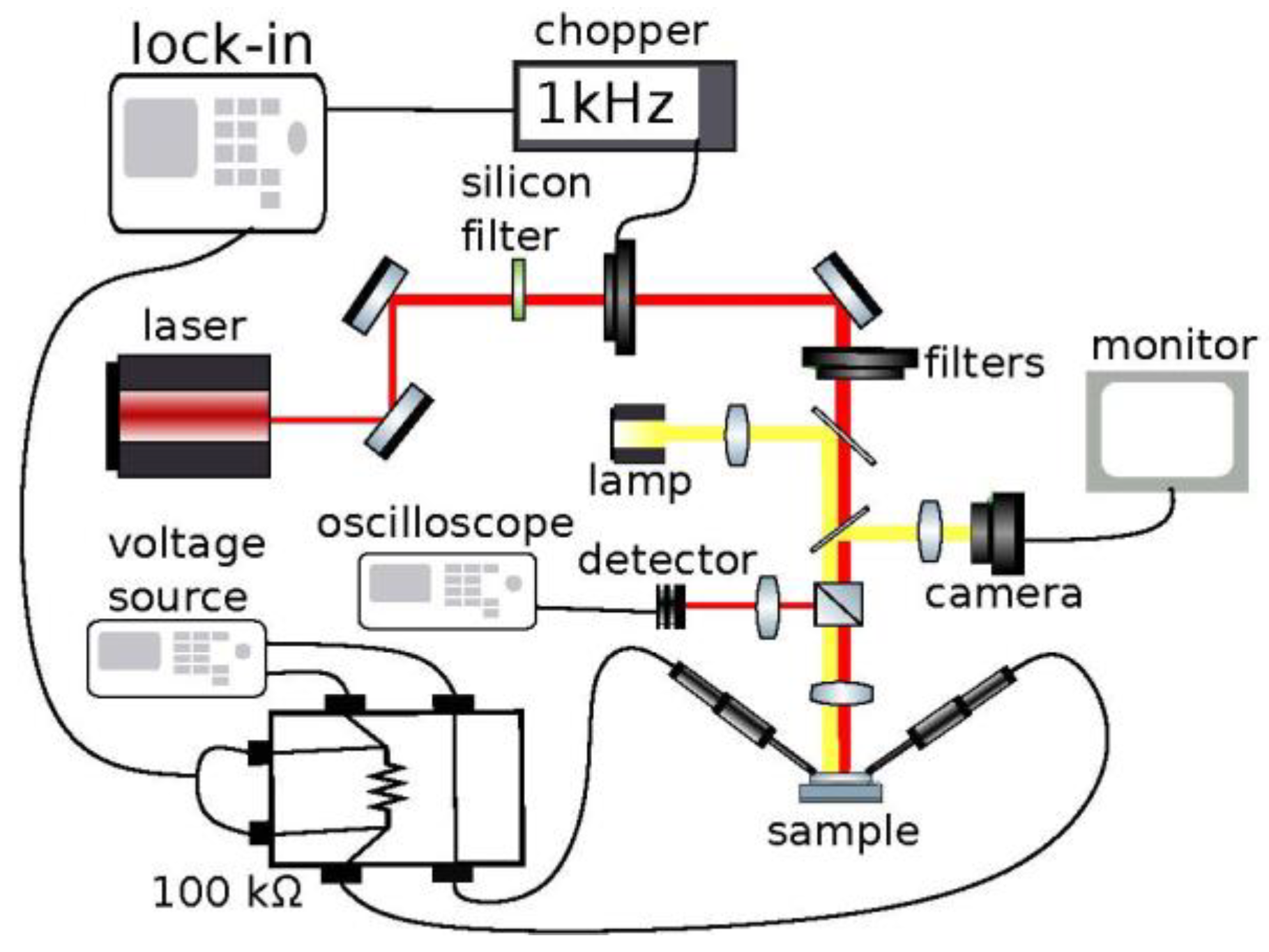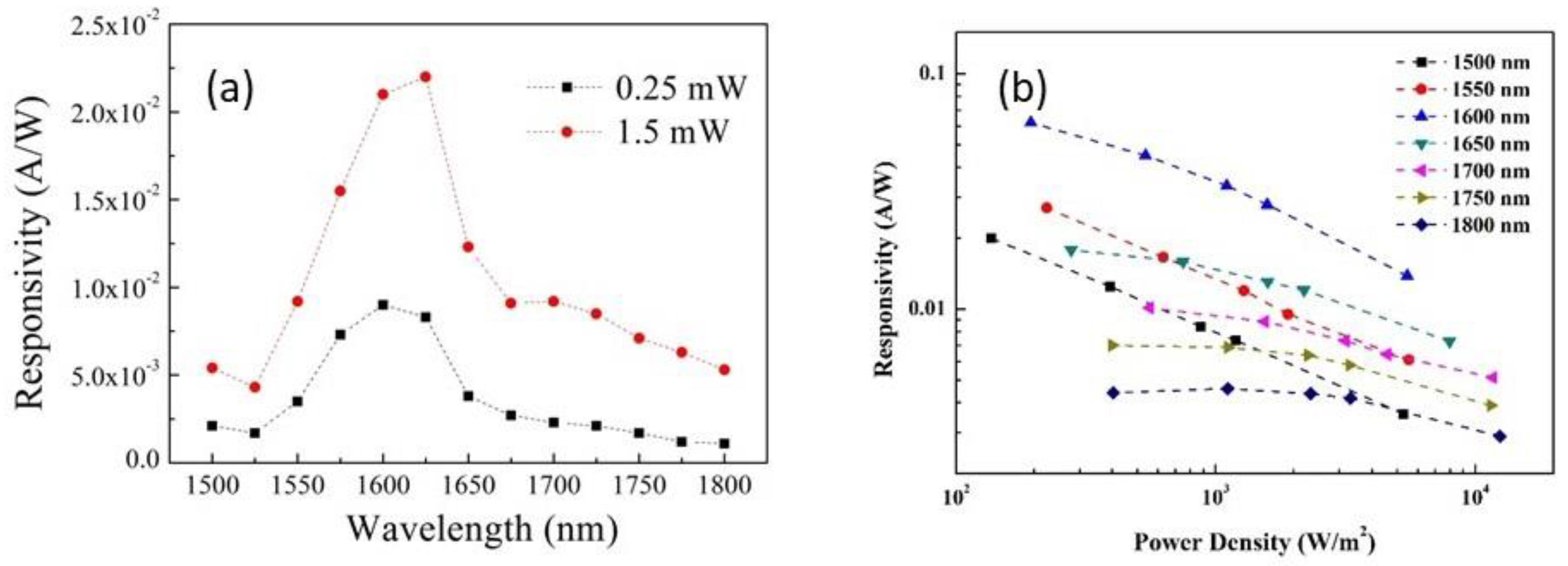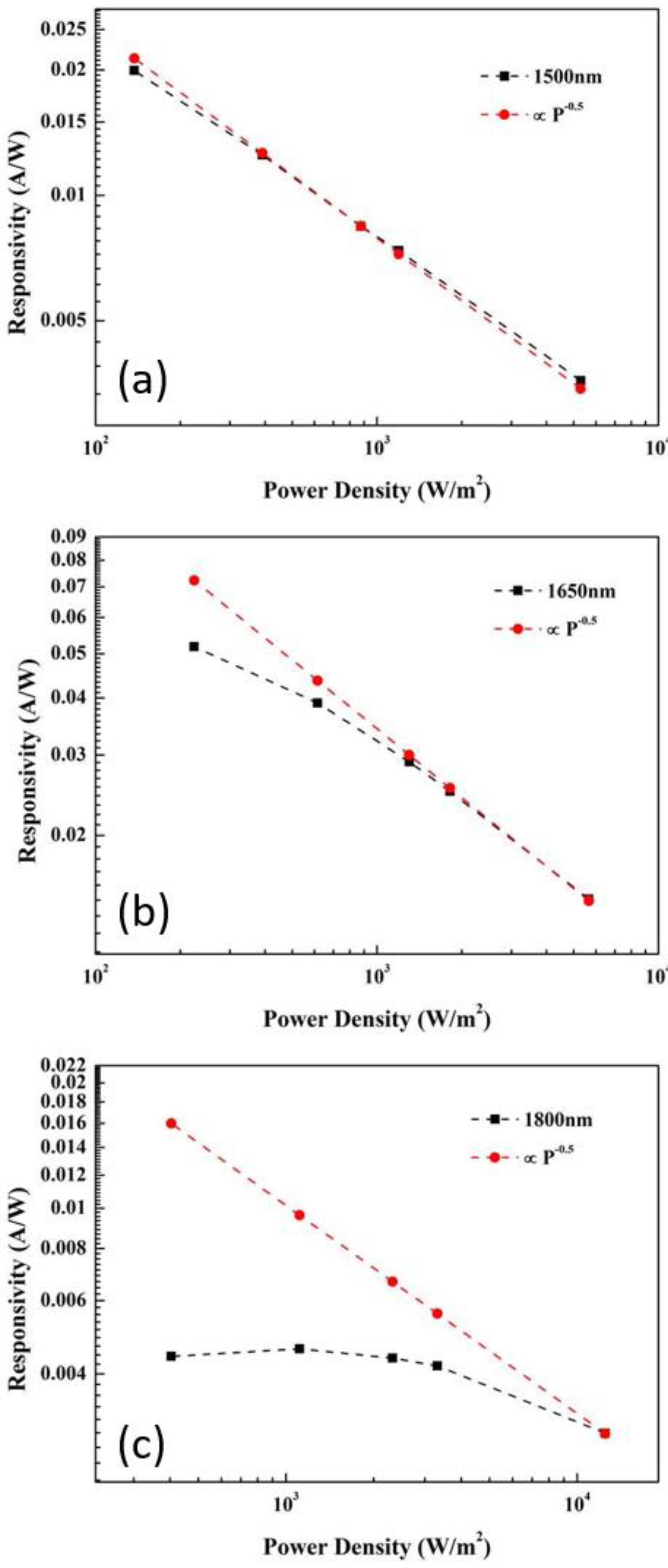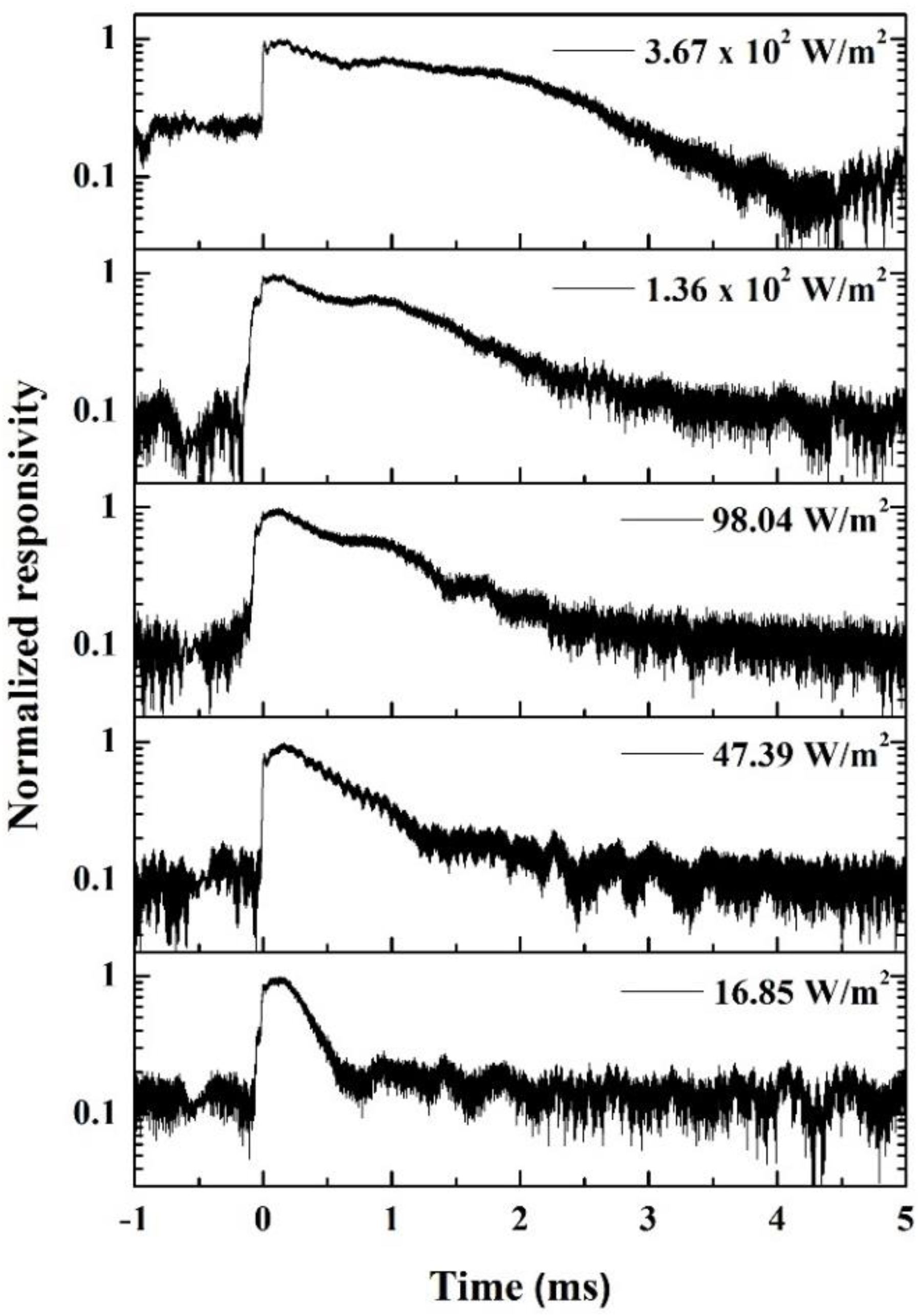Power-Dependent Investigation of Photo-Response from GeSn-Based p-i-n Photodetector Operating at High Power Density
Abstract
:1. Introduction
2. Materials and Methods
3. Results
4. Discussion
5. Conclusions
Author Contributions
Funding
Institutional Review Board Statement
Informed Consent Statement
Data Availability Statement
Conflicts of Interest
References
- Liang, D.; Bowers, J.E. Recent progress in heterogeneous III-V-on-Silicon photonic integration. Light Adv. Manuf. 2021, 2, 59–83. [Google Scholar] [CrossRef]
- He, G.; Atwater, H.A. Interband transitions in SnxGe1−x Alloys. Phys. Rev. Lett. 1997, 79, 1937. [Google Scholar] [CrossRef]
- D’Costa, V.R.; Cook, C.S.; Birdwell, A.G.; Littler, C.L.; Canonico, M.; Zollner, S.; Kouvetakis, J.; Menendez, J. Optical critical points of thin-film Ge1−ySny alloys: A comparative Ge1−ySny/Ge1−xSix study. Phys. Rev. B 2006, 73, 125207. [Google Scholar] [CrossRef]
- Yin, W.J.; Gong, X.G.; Wei, S.H. Origin of the unusually large band-gap bowing and the breakdown of the band-edge distribution rule in the SnxGe1−x alloys. Phys. Rev. B 2008, 78, 161203. [Google Scholar] [CrossRef] [Green Version]
- Huang, Y.-H.; Chang, G.-E.; Li, H.; Cheng, H.H. Sn-based waveguide p-i-n photodetector with strained GeSn/Ge multiplequantum-well active layer. Opt. Lett. 2017, 42, 1652–1655. [Google Scholar] [CrossRef] [PubMed]
- Morea, M.; Brendel, C.E.; Zang, K.; Suh, J.; Fenrich, C.S.; Huang, Y.-C.; Chung, H.; Huo, Y.; Kamins, T.I.; Saraswat, K.C.; et al. Passivation of multiple-quantum-well Ge0.97Sn0.03/Ge p-in photodetectors. Appl. Phys. Lett. 2017, 110, 091109. [Google Scholar] [CrossRef]
- Chang, G.-E.; Yu, S.-Q.; Liu, J.; Cheng, H.H.; Soref, R.A.; Sun, G. Achievable performance of uncooled homojunction GeSn mid-infrared photodetectors. IEEE J. Sel. Top. Quantum Electron. 2021, 28, 3800611. [Google Scholar] [CrossRef]
- Kasper, E.; Kittler, M.; Oehme, M.; Arguirov, T. Germanium tin: Silicon photonics toward the mid-infrared. Photon. Res. 2013, 1, 69–76. [Google Scholar] [CrossRef]
- Mathews, J.; Roucka, R.; Xie, J.; Yu, S.Q.; Menendez, J.; Kouvetakis, J. Extended performance GeSn/Si(100) 𝑝-𝑖-𝑛 photodetectors for full spectral range telecommunication applications. Appl. Phys. Lett. 2009, 95, 133506. [Google Scholar] [CrossRef]
- Su, S.; Cheng, B.; Xue, C.; Wang, W.; Cao, Q.; Xue, H.; Hu, W.; Zheng, G.; Zuo, Y.; Wang, Q. GeSn p-i-n photodetector for all telecommunication bands detection. Opt. Express 2011, 19, 6400–6405. [Google Scholar] [CrossRef]
- Oehme, M.; Schmid, M.; Kaschel, M.; Gollhofer, M.; Widmann, D.; Kasper, E.; Schulze, J. GeSn p-i-n detectors integrated on Si with up to 4% Sn. Appl. Phys. Lett. 2012, 101, 141110. [Google Scholar] [CrossRef]
- Gassenq, A.; Gencarelli, F.; Van Campenhout, J.; Shimura, Y.; Loo, R.; Narcy, G.; Vincent, B.; Roelkens, G. GeSn/Ge heterostructure short-wave infrared photodetectors on silicon. Opt. Express 2012, 20, 27297–27303. [Google Scholar] [CrossRef] [PubMed] [Green Version]
- Oehme, M.; Widmann, D.; Kostecki, K.; Zaumseil, P.; Schwartz, B.; Collhofer, M.; Koerner, R.; Bechler, S.; Kittler, M.; Kasper, E.; et al. GeSn/Ge multiquantum well photodetectors on Si substrates. Opt. Lett. 2014, 39, 4711. [Google Scholar] [CrossRef] [PubMed]
- Chang, C.; Li, H.; Huang, S.H.; Cheng, H.H.; Sun, G.; Soref, R.A. Sn-based Ge/Ge0.975Sn0.025/Ge p-i-n photodetector operated with back-side illumination. Appl. Phys. Lett. 2016, 108, 151101. [Google Scholar] [CrossRef]
- Zhou, H.; Xu, S.; Lin, Y.; Huang, Y.C.; Son, B.; Chen, Q.; Guo, X.; Lee, K.H.; Goh, S.C.; Gong, X.; et al. High-efficiency GeSn/Ge multiple-quantum-well photodetectors with photon-trapping microstructures operating at 2 μm. Opt. Express 2020, 28, 10280–10293. [Google Scholar] [CrossRef]
- Li, X.; Peng, L.; Liu, Z.; Zhou, Z.; Zheng, J.; Xue, C.; Zuo, Y.; Chen, B.; Cheng, B. 30 GHz GeSn photodetector on SOI substrate for 2 µm wavelength application. Photon. Res. 2021, 9, 494–500. [Google Scholar] [CrossRef]
- Xu, S.; Wang, W.; Huang, Y.C.; Dong, Y.; Masudy-Panah, S.; Wang, H.; Gong, X.; Yeo, Y.C. High-speed photo detection at two-micron-wavelength: Technology enablement by GeSn/Ge multiple-quantum-well photodiode on 300 mm Si substrate. Opt. Express 2019, 27, 5798–5813. [Google Scholar] [CrossRef]
- Chang, C.-Y.; Bansal, R.; Lee, K.-C.; Sun, G.; Soref, R.; Cheng, H.H.; Chang, G.-E. Planar GeSn lateral p-i-n resonant-cavity-enhanced photodetectors for short-wave infrared integrated photonics. Opt. Lett. 2021, 46, 3316–3319. [Google Scholar] [CrossRef]
- Roucka, R.; Mathews, J.; Beeler, R.T.; Tolle, J.; Kouvetakis, J.; Menendez, J. Direct gap electroluminescence from Si/Ge1−ySny p-i-n heterostructure diodes. Appl. Phys. Lett. 2011, 98, 061109. [Google Scholar] [CrossRef]
- Tseng, H.H.; Wu, K.Y.; Li, H.; Mashanov, V.; Cheng, H.H.; Sun, G.; Soref, R.A. Mid-infrared electroluminescence from a Ge/Ge0.922Sn0.078/Ge double heterostructure p-i-n diode on a Si substrate. Appl. Phys. Lett. 2013, 102, 182106. [Google Scholar] [CrossRef]
- Gallagher, J.D.; Senaratne, C.L.; Xu, C.; Sims, P.; Aoki, T.; Smith, D.J.; Menendez, J.; Kouvetakis, J. Non-radiative recombination in Ge1−ySny light emitting diodes: The role of strain relaxation in tuned heterostructure designs. J. Appl. Phys. 2015, 117, 245704. [Google Scholar] [CrossRef]
- Oehme, M.; Kasper, E.; Schulze, J. GeSn heterojunction diode: Detector and emitter in one device. ECS J. Solid State Sci. Technol. 2013, 2, R76–R78. [Google Scholar] [CrossRef]
- Chang, C.; Li, H.; Huang, S.H.; Lin, L.C.; Cheng, H.H. Temperature-dependent electroluminescence from GeSn heterojunction light-emitting diode on Si substrate. Jpn. J. Appl. Phys. 2016, 55, 04EH03. [Google Scholar] [CrossRef]
- Pham, T.; Du, W.; Tran, H.; Margetis, J.; Tolle, J.; Sun, G.; Soref, R.A.; Naseem, H.A.; Li, B.; Yu, S.Q. Systematic study of Si-based GeSn photodiodes with 2.6 µm detector cutoff for short-wave infrared detection. Opt. Express 2016, 24, 4519–4531. [Google Scholar] [CrossRef] [Green Version]
- Chang, C.; Li, H.; Ku, C.T.; Yang, S.G.; Cheng, H.H.; Hendrickson, J.; Soref, R.A.; Sun, G. Ge0.975Sn0.025 320 × 256 imager chip for 1.6–1.9 μm infrared vision. Appl. Opt. 2016, 55, 10170–10173. [Google Scholar] [CrossRef]
- Dong, Y.; Wang, W.; Lei, D.; Gong, X.; Zhou, Q.; Lee, S.Y.; Loke, W.K.; Yoon, S.F.; Tok, E.S.; Liang, G.; et al. Suppression of dark current in germanium-tin on silicon p-i-n photodiode by a silicon surface passivation technique. Opt. Express 2015, 23, 18611–18619. [Google Scholar] [CrossRef]
- Newman, R.; Tyler, W.W. Photoconductivity in germanium. Solid State Phys. 1959, 8, 49–107. [Google Scholar]
- Tran, H.; Du, W.; Ghetmiri, S.A.; Mosleh, A.; Sun, G.; Soref, R.A.; Margetis, J.; Tolle, J.; Li, B.; Naseem, H.A.; et al. Systematic study of Ge1-xSnx absorption coefficient and refractive index for the device applications of Si-based optoelectronics. J. Appl. Phys. 2016, 119, 103106. [Google Scholar] [CrossRef]





Publisher’s Note: MDPI stays neutral with regard to jurisdictional claims in published maps and institutional affiliations. |
© 2022 by the authors. Licensee MDPI, Basel, Switzerland. This article is an open access article distributed under the terms and conditions of the Creative Commons Attribution (CC BY) license (https://creativecommons.org/licenses/by/4.0/).
Share and Cite
Chang, C.; Cheng, H.-H.; Sevison, G.A.; Hendrickson, J.R.; Li, Z.; Agha, I.; Mathews, J.; Soref, R.A.; Sun, G. Power-Dependent Investigation of Photo-Response from GeSn-Based p-i-n Photodetector Operating at High Power Density. Materials 2022, 15, 989. https://doi.org/10.3390/ma15030989
Chang C, Cheng H-H, Sevison GA, Hendrickson JR, Li Z, Agha I, Mathews J, Soref RA, Sun G. Power-Dependent Investigation of Photo-Response from GeSn-Based p-i-n Photodetector Operating at High Power Density. Materials. 2022; 15(3):989. https://doi.org/10.3390/ma15030989
Chicago/Turabian StyleChang, Chiao, Hung-Hsiang Cheng, Gary A. Sevison, Joshua R. Hendrickson, Zairui Li, Imad Agha, Jay Mathews, Richard A. Soref, and Greg Sun. 2022. "Power-Dependent Investigation of Photo-Response from GeSn-Based p-i-n Photodetector Operating at High Power Density" Materials 15, no. 3: 989. https://doi.org/10.3390/ma15030989





